As a brand-new owner, the first few weeks of tinkering around with the device were fun, but as soon as I started my Steam Deck SD card journey, things started falling apart. Worldwide delivery costs went up, hardware availability went down, and I can’t say that the different specs of all the compatible MicroSD cards were easy to understand.
Googling didn’t help either, mainly because of bad journalism and even worse search engine optimization practices. Tons of sites out there claim to have found the best SD card for Steam Deck, but from just looking at their stock photos, you can tell that they never even attempted a review, let alone know which MicroSD card pairs best with the console.
So, I figured that if I wanted to find the best of the best, I would need to roll-up my sleeves and do the testing myself.
Picking the Right Steam Deck Micro SD for the Test
Before I went ahead with the purchase, I first tried to understand the specs outlined by the SD Association, the governing body behind the SD standard. Similar to a Steam Deck SSD, the cards themselves have speed ratings, so by learning how to read their specifications, I understood which models wouldn’t be the ideal Steam Deck Micro SD by just looking at their read and write speeds.
Once I got that out of the way, I ended up with a list of 12 different models from 7 brands, two of which were out of stock. Once they are back, I’ll include them in this test.
To weed out the bad performers, I combed through all of them by using various synthetic and real-life performance tests. Once that was done, I compared the results with their prices and availability, and finally came to a conclusion for which one would be the recommended SD Card for Steam Deck.

The 10 models that made it to my Steam Deck SD card test
If you’re interested in the full process, I’m leaving you an almost 6000-word text below, where you can find all the possible information you would need when purchasing a Steam Deck SD Card. If you don’t want to bother with the whole research thing and just want a TL;DR, I’ll get right to the point here:
SanDisk Extreme is the Best SD Card for Steam Deck
Out of 15 different models, the SanDisk Extreme series didn’t just have the strongest brand, warranty and availability, but also outperformed the majority of the Steam Deck SD cards I tested out in both synthetic and real-world performance scenarios. Additionally, SanDisk is one out of only two brands that currently offers 1 TB MicroSD cards worthy of the Steam Deck, so picking it as the clear winner was easy.
The 256 GB version would probably be your cheapest option at only $39. The 512 GB almost doubles that amount to $73, while the behemoth of the bunch, the 1 TB MicroSD card, will cost you $199, depending on the season.
The only downside that I found here is that this specific brand is heavily counterfeited, and I wouldn’t suggest purchasing it through eBay, Alibaba or any other store that has third party sellers. I would recommend buying from SanDisk’s official Amazon store.
The PNY Pro Elite is the Budget 1 TB Steam Deck SD Card
Large capacity MicroSD cards can get expensive (with the SanDisk Extreme above being a good example) but if you’re willing to sacrifice a portion of the performance to get a better price, then the PNY Pro Elite is your best bet.
Out of all of the Steam Deck SD cards I used in this test, the PNY Pro Elite had the best balance between an affordable price and large storage, with the 1 TB version going for around $149– 25% less than the Extreme Series. For that price, you’ll get a card that not only looks good, but also performs better than the majority of them. Other sizes are also a bit cheaper than the SanDisk Extreme series, which makes them the perfect choice for bulk buys. So, if you’re looking for a decent performer with a large capacity and affordable price, the 1TB PNY Pro Elite is the recommended SD Card for Steam Deck.
Now, if you’re still with me and want to hear all about my testing journey, below is the long-ass text.
Does the Steam Deck Have an SD Card Slot? Duh…
Upon the arrival of the console, my younger colleague was wondering where the Steam Deck SD card slot is and I can’t blame him, because the entry port looks like a skinned down oversized USB-C port. If you haven’t been following the product and, you know, reading the manual, it’s easy to miss.
If you look at the plethora of other gadgets that support the MicroSD standard, the slots usually tend to come labeled, with an obvious point of entry. The examples that I currently have at hand are my Nintendo Switch and the 2DS XL; both devices have their MicroSD Card slot clearly labeled, with an image showing which way is up, and which is down.
Valve, on the other hand, decided to leave their Steam Deck Micro SD slot unlabeled, but if you take a closer look at the console, you’ll find it on its belly, in the middle right section. To insert your card, face it right side up, insert it in to the opening and push it gently with your nail until you hear a solid “click”.

So, if you didn’t know before, now you do. The most important thing here is the module that is inside, which brings me to my next point.
Which MicroSD Card Standard Does the Steam Deck Support?
I’ll go into different options soon, but before I do that, I wanted to make it clear that the Steam Deck is designed to work with UHS-I MicroSD cards (also called UHS-1 in some cases). When I say “designed,” I mean that that’s the ideal scenario for the console.
As with every MicroSD card slot out there, the Steam Deck has backward and some forward compatibility. It can support various standards, including Micro SD, Micro SDHC and Micro SDXC, but there’s a caveat: the faster cards might not perform well with the device, as you’ll soon see, and the slower ones can and will ruin your gaming experience.
Weeding Out the Worst Steam Deck SD Cards on the Market
As I already mentioned in the intro, during this test I had quite a handful of models on my desk. But before I pressed the purchase button on all of them, I first had to weed out the obvious low performers.
This was my process:
- I ignored SD cards with advertised read speeds below 60 MB/s. From my past experience with the Nintendo Switch, I already knew that MicroSD cards with an advertised read rate below 50 MB/s are no good: the loading times are awful and it’s just not worth cheaping out on them. This industry is tied to numbers, and if a card says that it’s slow, it’s probably even slower than that. Later on, you’ll find out that both the write and read speeds are just numbers that the manufacturer reached in “ideal conditions” and the real-life performance may vary. My best example here would be Samsung’s Pro Plus MicroSD, and I’ll touch upon that soon.
- After that came the brand recognition. This one is tied to common sense; if you see that the brand is called “SD Card”, they only offer SD Cards, and their design mirrors SanDisk or other manufacturers with recognizable colors, then it’s probably not worth the hassle of ordering and returning.
- Then I included some biases. In the past, I have had some bad experiences with cards from the V90 range, where they just didn’t want to play nice with my photo and video gear, and since the Steam Deck wouldn’t be capable of using those speeds in the first place, I just decided to ignore them completely. If you think that you’re missing out and want to conclude your own test, I would recommend the ADATA Premier One.
Once that was out of the way, I started focusing on what I actually wanted from the perfect SD card for Steam Deck, and I found 10 models from seven different brands: Lexar, PNY, Western Digital, Kingston, Samsung, Gigastone, and SanDisk.
Behind the Best Steam Deck SD Card
The governing body behind the standard, the SD Association, is trying to cater to everyone from casual phone users and gamers up to videographers, photographers and car enthusiasts. The more industries there are, the more markings are needed. Luckily for us gamers, the situation is straightforward, and I created the following testing methodology to pick out the best performers.
- Synthetic Read and Write Speeds – Marketers are a funny bunch, and they usually love to create the perfect environment to test their products, and then use those numbers to boost their marketing campaigns. Nevertheless, like I already said above, advertised speeds are a good pointer for weeding out the worst performers, but to truly test the SD cards I had to comb through them by employing synthetic tests. Tools like ATTO and CrystalDiskMark were my best friends here, and they are freeware so feel free to test them out yourself. With their help, you can stress out your potential Steam Deck SD card by mimicking real life performance on a 8 GB file, and then get the real read and write speeds.
- Storage Capacity – A 1 TB Steam Deck SD card is still a unicorn in this industry, mostly because they are still new to the market. It has been just a few years since SanDisk announced their first one, and aside from PNY, most other manufacturers haven’t caught up. In other words, if you want to buy a 1 TB Micro SD, you only have two brands to choose from. I hope that will change soon, especially thanks to the handheld gaming boom that is being led by Nintendo, Valve and indie manufacturers.
- Game Download Speeds – I have a 1 Gigabit wireless connection, so I tried to complement the synthetic tests by taking a game of the same size, 8 GB, and downloading it directly onto the MicroSD, basically forcing the card to write at the max speed it can develop.
- Game Loading Speeds – Once I had the games downloaded and installed on each Steam Deck Micro SD, I then measured how long it took for the console to read from them. The most convenient method that I found was launching CS:GO and then loading Dust 2 with bots.
- Game Performance – This is where I was searching for any FPS drops and stuttering by replaying the same level of the game and keeping track of the FPS performance. This is not common practice, but I still wanted to include it since I had some stuttering with a slower MicroSD card back in my Nintendo Switch days.
- Bonus: The Bus Interface, also known as the SD Card Standard – As I previously mentioned, your Steam Deck is limited to the UHS-I standard. Theoretically, even if you got a UHS-II microSDXC card for Steam Deck, the device would “downgrade” it and deliver only UHS-I performance. So, in other words, you would pay more for the UHS-II model, but still have UHS-I performance. The question that I had here (and that none of the reviewers answered properly) was, would a capped UHS-II MicroSD card work faster on the Steam Deck than a maxed out UHS-I MicroSD card? Since no one did that test and everyone blindly followed the UHS-I recommendation, I went ahead and ordered one UHS-II model, the Lexxar Professional. I’ll reveal my results soon.
After two days of testing, recording and playing I finally ended up with four excellent performers, one cheater, two copycats and one utter disappointment. Let’s first start with the best SD card for Steam Deck.
Best Micro SD for Steam Deck: SanDisk Extreme Series
Out of the 10 different models that I had in front of me, only two had a 1 TB MicroSD card option: the PNY Pro Elite and the SanDisk Extreme series. Although I love PNY and their recent design language, the synthetic and real-world performance showed that SanDisk is the clear winner in the 1 TB segment and deserves the title of the best Steam Deck SD card.
The SanDisk Extreme MicroSD card had the fastest write speeds paired with decent read speeds that either outperformed or matched the rest of the bunch. Besides the hefty price point, I couldn’t find any real downsides to this particular model, except that it’s heavily counterfeited by various third-party shops. So, once more, if you want to get the genuine card, be sure to order directly through SanDisk’s Amazon store.
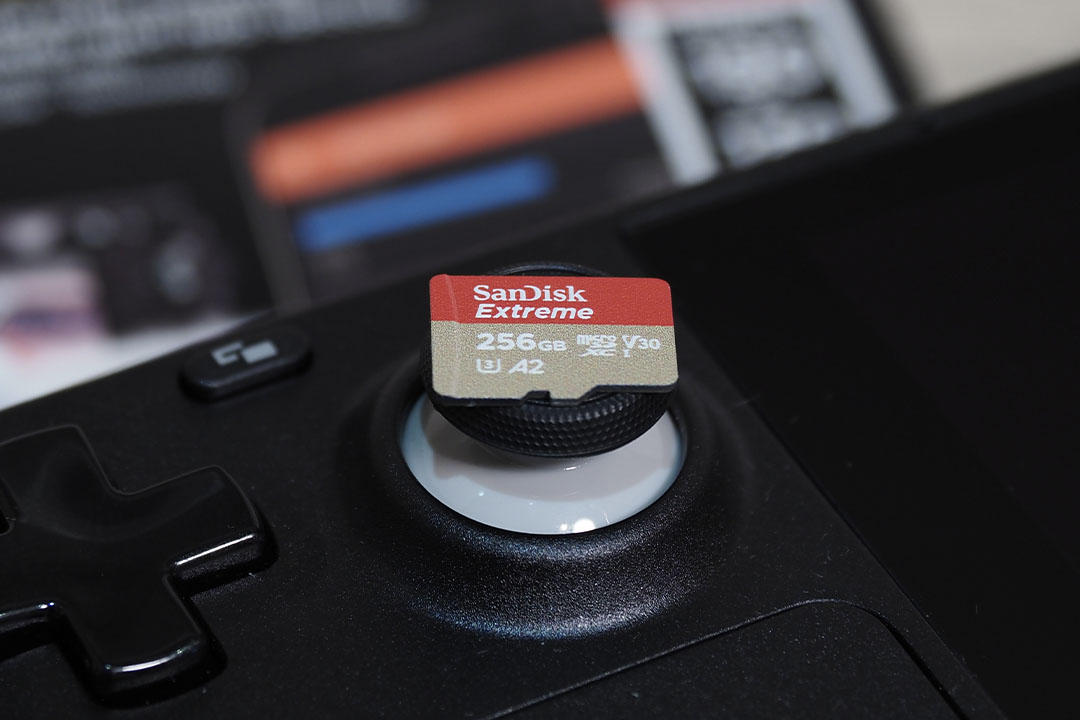
The Affordable 1TB SD Card: PNY PRO Elite Series
If you’re planning on creating a collection of 1 TB Steam Deck SD cards, you’ll soon figure out that it’s a costly hobby, especially if you’re looking at the SanDisk Extreme series I talked about above. But, if you’re willing to sacrifice a portion of the performance to get more storage, then the PNY Pro Elite series is your best bet.
Out of all the Steam Deck Micro SD cards that I tested, this particular model had the best balance between price and storage. It will not match the performance of the SanDisk Extreme series, but what it lacks in performance it makes up for in price. The 1 TB version goes for around $149, depending on the time of year, which is 50 bucks less than the SanDisk Extreme above. Other than that, the brand is recognizable, the warranty is on point, and the world-wide availability of 1 TB models is excellent.
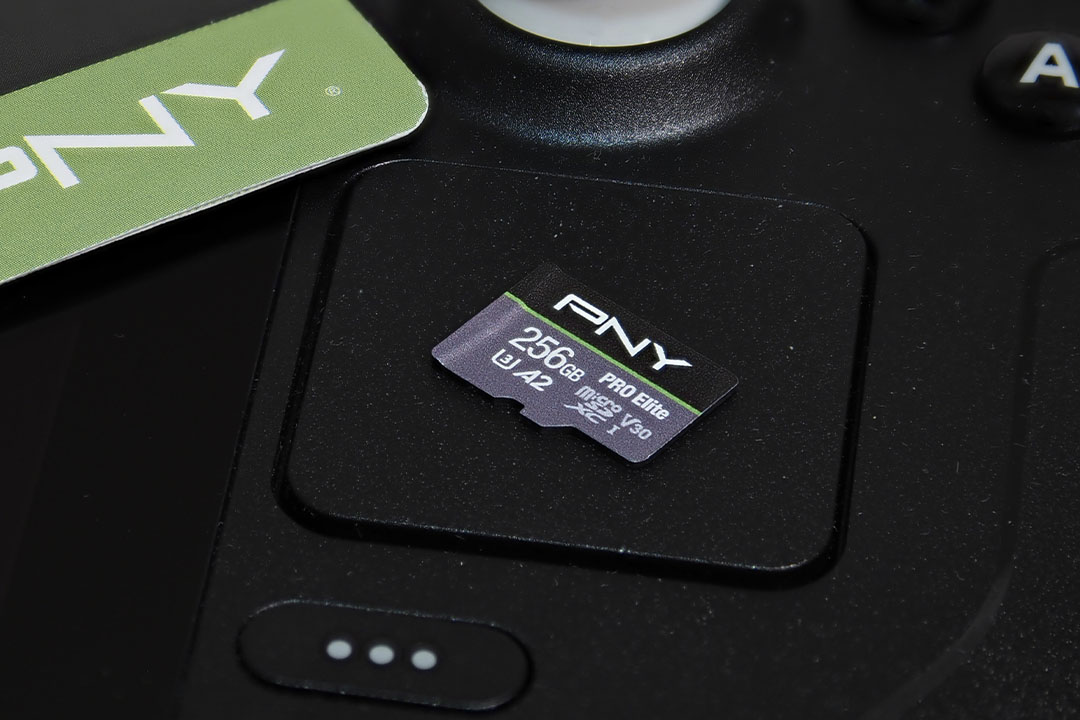
The Best 512 GB Steam Deck SD Card: PNY XLR8 Gaming
This was one of the best surprises that I had at this test. I usually run away from every product that is labeled “for gaming”, but this one changed my mind. The PNY XLR8 MicroSD card was, in my humble opinion, the best-looking card out there. It’s not just a pretty face: the performance was amazing too.
It outperformed five competitors in real-world write scenarios, and if you think that’s not impressive, wait until you find out that the XLR8 had *the fastest* read speeds out of all of them. Sure, we’re talking about a margin of just a few seconds, but it adds up in the end and I think it’s still worth praising what PNY did with the UHS-I standard.
The downside? Unfortunately, there’s no 1 TB version available… The only models that you can get are the 128 GB version for $15, the 256 GB one for $28, and my own personal choice, the 512 GB for $59. Hopefully PNY will figure out that the XLR8 has potential and they’ll eventually introduce a 1 TB model.
To conclude, the PNY XLR8 has an excellent price, even better performance and a cool design – definitely recommended if you’re searching for a 512 GB Micro SD card for Steam Deck.

Best-looking Steam Deck Micro SD: SanDisk Nintendo Collab
Let me just be clear: SD cards are not tied to one specific device. This model is heavily advertised as being a “Nintendo Switch” card, but it’s your standard SanDisk MicroSD, just rebranded. Originally I wouldn’t have recommended this specific series, as they were ridiculously expensive when they first came out. All of the models cost 2.5x or more, but that has changed a lot in the past year and the market has corrected their prices.
In other words, if you’re a fan of Nintendo (or Apex Legends like myself), you’ll be happy to hear that there are some dope designs available. Additionally, since the strict Nintendo is behind the project, the counterfeit industry is ignoring this specific series, and even if you would buy it from a regular store, chances that you’ll get scammed are slim to none. The only downside is that the speeds don’t match the excellent design. I first thought that I was looking at the same Extreme series model I reviewed above, but once I concluded my test I was a bit surprised. Yes, the real-world read speeds did match the Extreme series, but the write speeds were a tad slower.
Nevertheless, if you’re looking for a splash of color or are building a Nintendo-dedicated Steam Deck SD Card for emulation, these unique nuggets can be a great addition to your collection. Below are all the models that are available, and here’s the direct link to them: SanDisk Nintendo Licensed MicroSD Cards. 
The Cheater: Samsung Pro Plus UHS-I A2 V30 MicroSD Card
You might raise an eyebrow when you see a manufacturer claiming that their UHS-I standard card can reach up to 160 MB/s read and 120 MB/s in write speeds. I sure did. On top of all that, they even give you a free USB 3.0 SD card reader so that you can “test it out by yourself”. Now doesn’t that sound like a cat in a sack? I did several tests with the Samsung Pro Plus and I got mixed results in each of them. Below is an overview of my findings.
In the first line, you’ll find the advertised read and write speeds. In the second you’ll see the synthetic tests via their USB 3.0 reader, and in the third you’ll see the same test, just with a third party one. Finally, you’ll find another one with an SD Card adapter directly plugged into my laptop. Can you see the difference?
[Image 1] [Image 2] [Image 3]
With a fishy taste in my mouth, I placed the synthetic tests aside and went directly to real life performance. The card underperformed in my game download test, and kinda performed well in the loading test. Still, I can’t say that I’m happy with the whole package.
Besides the major disappointment called “Lexar” we’ll be discussing next, Samsung was among the worst-performing cards at this test. Now, I’m not here to do a “shocking” YouTube video with a clickbaity title and a surprise face thumbnail, I just want to find the best Steam Deck SD card, and the Samsung Pro Plus isn’t one.
But if you think that was bad, wait until you hear about this…
The Disappointment: Lexar Professional UHS-II A2 V60 MicroSD Card
I really wanted to love the Lexar Professional series… The design, packaging and overall vibe were great, and I hoped that I would get peak (but capped) UHS-I performance from a UHS-II card, but what I got in the end was just wasted time and money.
The peak performance of 55.6 MB/s could be seen in the first minute, which was almost 40% above the rest of the cards, but soon enough it crashed down to 2 MB/s and started performing worse and worse. The lowest points I saw were either 200 to 500 kb/s breadcrumbs or a complete zero. While most cards downloaded an 8 GB file in less than 4 minutes, the Lexar Professional took an astonishing 30 minutes. I thought that the read speeds would outperform write speeds, but that wasn’t the case. It took me 4 minutes and 23 seconds to load one simple bot match in CS:GO.
This was the model that I intended to keep as my dedicated Steam Deck SD card for competitive gaming, but as it seems I will need to either return it or repurpose it. Pity.
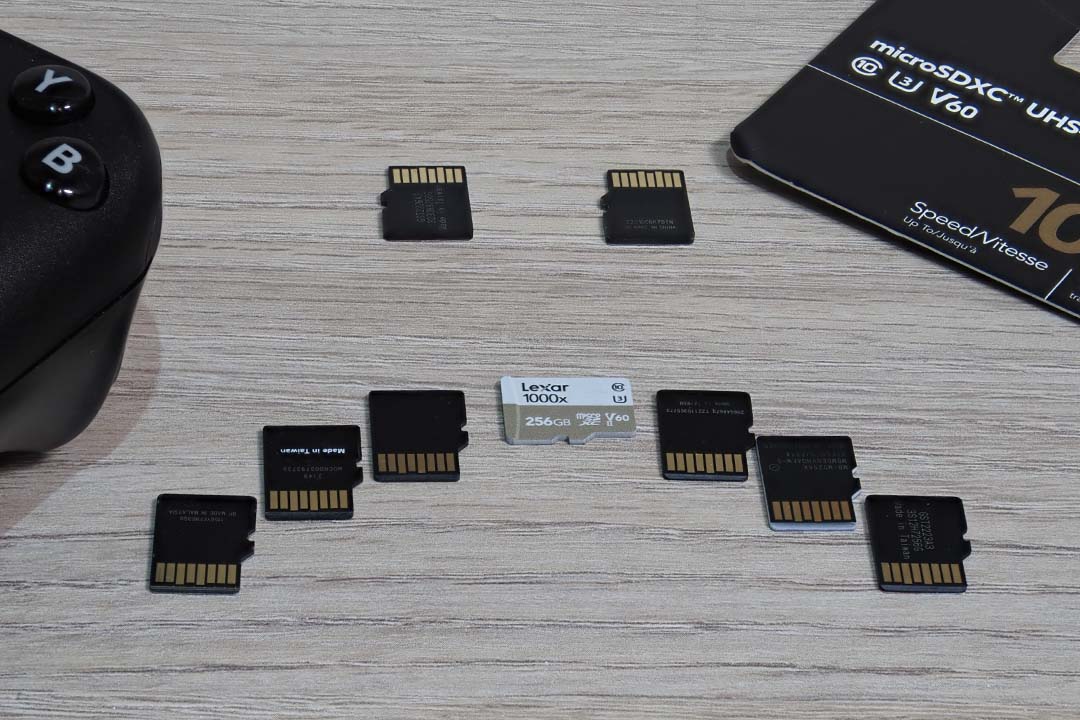
The Copycats: Gigastone MicroSD Cards
As seen in the tables, I had two Gigastone cards in the test: the 4K Camera Pro and the Gaming model. My spidey senses started tingling once I saw that the name is a variation of Kingstone and the design resembles SanDisk, but I still wanted to try them out. The price was a few dollars higher when compared with other models, but I thought to myself that maybe it’s justified – it wasn’t.
Both models underperformed in all tests, but in their defense, it’s not like they were advertising anything higher. I think that this was the only manufacturer who truly offered what they promised – a MicroSD card with a 100 read and 60 write specs.
What’s even worse is that, when you compare them side by side, the dedicated gaming card was the low performer, while the 4K Camera Pro matched Samsung’s Pro Plus mentioned above.
Gigastone is not the best SD Card for Steam Deck: avoid them if you can.
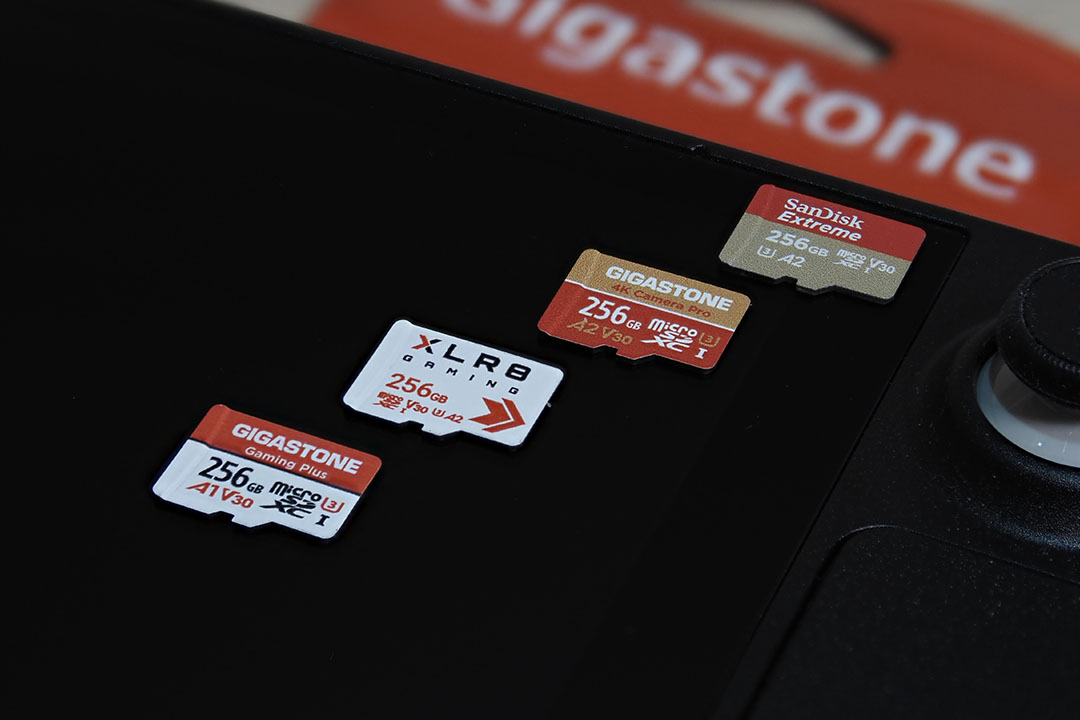
The Full Steam Deck SD Card Conclusion
If you’re into data and infographics, I’ve collected the numbers from all of my tests and ranked the cards from best to worst. Just keep in mind that I didn’t focus purely on the numbers: a card with good speeds, a stronger brand, better availability and more size options will rank higher.
[Best SD Card Steam Deck Infographics]
Where Can a Slow Steam Deck Micro SD Hurt Me the Most?
What if you got a Steam Deck Micro SD as a gift and the person purchasing it didn’t read our guide? Is it the end of the world? Nah, not at all, but with a slow card you’ll most likely encounter one (or more) of these three scenarios:
- Longer Download Times – I personally don’t mind this too much; waiting an additional minute or two for a game to download isn’t a big thing for me, but it might be for you. What does bother me, though, are read times, which brings me to the next point.
- Longer Loading Times – This is a bummer. The Lexar card that I had in this review took four and a half minutes to load a map in CS:GO. Multiply that by 5 matches and that’s 20 minutes wasted just on looking at the loading screen. And that’s just the beginning of it: wait until you’re actually on the map, that’s where the real issues start with frame rate.
- Stuttering and Frame Drops – If you have an older model in your Steam Deck SD card slot, the game will take longer to load assets from it, not only on the loading screen like I mentioned above, but also during gameplay. This is most commonly seen in open-world games like RDR2 or The Witcher 3, where the assets load as you move around. If the game can’t load the assets as fast as you’re moving, it will start to slow you down until it loads them properly.
This is why I think that, for the best experience, you have to have a decent SD card for Steam Deck, otherwise it’s just a gamble.
Can I Prepare My Steam Deck SD Card Beforehand?
Steam Deck is running on SteamOS, which in turn is a sub-version of Linux, and as with every distro out there, you will have some smaller quirks that aren’t working exactly how they should once transferred to Windows or Mac.
In this specific case, a Steam Deck MicroSD Card will not work with Windows and Mac by default, since they are formatted in the EXT4 journaling file system. To fix that, you would need to employ several steps beforehand. I wrote about it in this article here and honestly, I wouldn’t recommend it if you have never in your life formatted a drive.
The reason I’m saying that is because it takes too much time if you’re not a techy person, and if you don’t know what you’re doing, you might format the wrong drive. It’s better to wait until your Steam Deck arrives and then sort out everything on the spot.
Is a Larger Steam Deck Micro SD Slower than a Smaller One?
No, larger MicroSD cards are not generally slower than smaller ones. I could place a stupid joke here with a “the size doesn’t matter” quote, but it’s true. What does matter are the specs, and some people confuse storage capacity with performance.
For an example, if you placed a SanDisk Ultra UHS-I V30 256 GB and 1 TB next to each other and compared their performance, you would get identical results, but if you would place a 256 GB UHS-II V90 MicroSD Card with a 1 TB UHS-I V30 one, the latter would lose.
So, the specs are what make the difference, not the size.
Does the Steam Deck Support 2TB MicroSD Cards?
Theoretically, the Steam Deck max SD card size is set to 2 TB, but… none of those are available. The industry is much slower than you think; the proof for that is that the first 1 TB MicroSD Card was introduced just a few years ago, from SanDisk. Meaning that almost until the end of 2019, there were no 1 TB models on the market, with the largest option being 512 GB announced 5 years before.
Even if you scroll up a bit and re-read what I wrote about the availability of 1 TB models, the fact is that only two out of six brands support that size.
The problem isn’t the manufacturers, but rather the consumers (or at least, that’s what we’re told).
The same year the 1 TB MicroSD card debuted, the university of Hertfordshire did a case study on the storage capacity of memory cards purchased in 2018, and less than 5% of users were buying cards larger than 32 GB, with tons of professionals from that era claiming that smaller is better.
Users just didn’t want to invest so much money into a single card and risk losing their work due to unforeseen circumstances. Even nowadays, if you ask any photographer out there they will tell you that their card collection consists mostly of models between 128 and 256 GB.
The industry is moving bit by bit though – Micron just recently announced their 1.5 TB MicroSD Card that is focused on the automotive industry – but it will still take some time for other manufacturers to catch up, and for the demand of those large MicroSD cards to rise.
Will we see a 2TB SD card for Steam Deck any time soon? Well, maybe we’ll see an SD renaissance now that the Steam Deck is here, but who knows.
Is a Steam Deck SD Card Hot-swappable?
The Steam OS that comes preinstalled on the device doesn’t mind if you hot swap SD Cards, it even has a notification that tells you if the right drive isn’t plugged in. In other words, you can have one Steam Deck Micro SD for Indie games, one for AAA games, one for competitive gaming and so on, but you need to be careful with them.
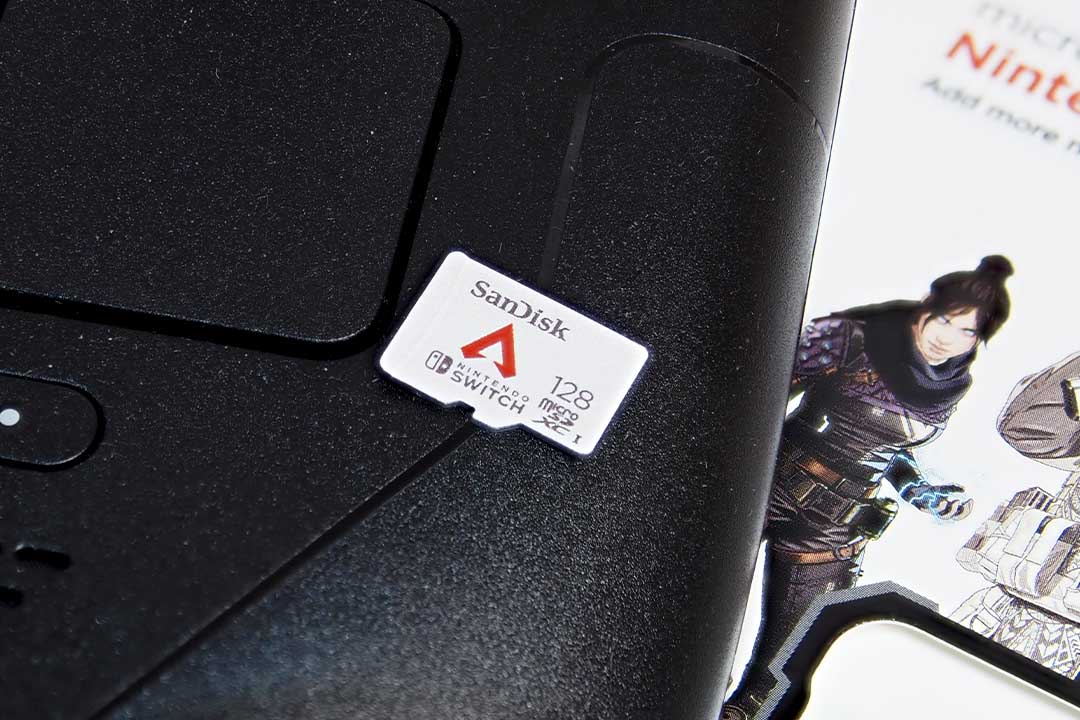
The Nintendo Sigil Edition can be your dedicated Apex card
Since SteamOS is still new, it’s lacking some basic storage management functions, with the “Eject” option being the main one. Yes, some emulators like Dolphin do have it, but the general file system of the console doesn’t.
In other words, there’s a risk of corrupting your Steam Deck SD Card if you’re constantly hot swapping them in the middle of their read or write cycle. The best option here is to completely turn off the console, and then replace the MicroSD card. That way you’ll be 100% sure that you’re not pulling out the card mid-cycle.
My own setup includes several Steam Deck Micro SD cards, from smaller 32 GB versions for Indie games up to 256 GB for AAA titles, and I made custom stickers for them as well. Check out the image below to see what they look, and if you would like to make your own, I wrote a how to guide here: Steam Deck DIY SD Card Game Stickers.
How Reliable Are Micro SD Cards in General?
Even the best models out there don’t have a definite lifespan: some manufacturers advertise up to 10 years, others promise a lifetime, but the general consensus is that it depends on several factors and no one can produce a reliable number, especially for devices with heavy usage like dashcams that constantly read and write over and over again.
So, when you’re looking at these claims, you have to go granular, because they differ from source to source.
- If you ask the SD Association, it’s up to 10 years of moderate usage. In their own words, the lifespan of a MicroSD card can outlast the lifespan of multiple compatible devices, from cameras and drones up to your Steam Deck.
- If you ask the manufacturers, it’s over 10 years with some small print in-between. Lexmark and Sandisk as an example, offer a Limited Lifetime Warranty on their products, promising a lifespan of over 10 years, with certain limitations of course.
- If you ask photographers and videographers, you’ll get mixed but honest opinions. From my understanding and the research I did on various photography subreddits and forums, the consensus between all professionals is that SD Cards perform well for the first three to five years of their lifetime if you’re an active user, and after that period it’s a mixed bag regardless of the brand you’ve purchased. Additionally, all of them agreed that SD Cards aren’t reliable long term storage solutions for important data, which isn’t a big problem for our current scenario since the Steam Deck is cloud-based, and all of your saved data is stored on both the internal SSD and in their cloud.
The conclusion here is simple: if you just bought a new Steam Deck SD card and you’ll use it solely for installation files, then relax and enjoy your console. The worst thing that could happen is that in 3 to 5 years your card will die and you’ll need to reinstall your games.
So, are there SD cards that can last longer than my relationship with my ex? Yes, they are called High Endurance MicroSD Cards.
Is it Worth Buying a High Endurance SD Card for Steam Deck?
As if the SD Association didn’t already over-complicate the naming scheme, now they have also added another model called “High Endurance”. Since we’re in a marketing world, the word “endurance” can be misleading, but there are some factors that stand out when it comes to MicroSD cards following that standard.
- More Write Cycles – As you know, each storage device has a limit, and with MicroSD cards it’s all about them write cycles. Outside of gaming, there are industries that are in need of storage that has more write cycles. The first example would be the automotive world and their dashcams, the second would be the security industry with their webcams, where in both situations the cameras are constantly deleting and writing onto the MicroSD card, 24/7.
- Wear Leveling – Just a handful of manufacturers employ wear-leveling technology in MicroSD cards; you won’t find that feature in their regular line-up of cards, but their High Endurance selection might have it. To first explain what wear leveling is, basically, your MicroSD Card is made out of small blocks: the more gigabytes you have, the more blocks there are. Each block has a certain write cycle, as we explained in the point before. A regular SD card might find itself in a situation where it’s constantly deleting and writing over the same pair of blocks, shortening its lifespan, while a High Endurance one can manage its resources more efficiently and use all the blocks on the card, from nose to tail. This keeps the write cycles of each individual block low, meaning that, in the end, you’ll get a better lifespan.
- More Robust – This is where bullshitting comes in. Now, I’m not a scientist or engineer, so I’m not going to go into too much detail, but what the manufacturers are claiming is that you’ll get a more robust card that can survive extreme temperatures and fluctuations, high levels of shock and vibration, x-rays and whatnots. I’ll leave it to you to be the judge of this.
Does it make sense to buy a high endurance MicroSD card for the Steam Deck? Completely up to you. From my point of view, as a reviewer, I don’t see any proper benefits to it. Sure, you might squeeze a few years more out of your Steam Deck SD card, but you’ll pay more for it, and you’ll get slower loading times. I tested the Western Digital Purple SC QD10 a few months ago and barely got 22 MB/s in synthetic read speeds, and God knows how long it would take to load a map on that. It’s a good card for dashcams though. you want to check it out, follow this link:
Can you Re-Use Older MicroSD Cards with the Steam Deck?
If you’re a gadget hoarder like myself, you probably have a device or two lying around your room or attic with a MicroSD Card popped into it, it just depends how old the device and the card itself are. In my own case, I had an older GoPro model that I bought pre-pandemic and used exactly three times after. In it, I found an older SDXC Class 10 A1 MicroSD card from SanDisk. That 256 GB would have been a waste of money if left to rot inside the GoPro, so repurposing it as a dedicated Steam Deck Micro SD made sense, and I was lucky enough that the speeds are still up to the standard. But what about older cards?
Can I use Older SDHC Class 10 MicroSD Cards With Steam Deck?
If you just want to test out the port or not store games on it, then sure, why not. It will work, but the performance will be bad and you’re stuck with a maximum of 32 GB of storage.
Remember the long loading times we had on the third generation of consoles, like the PS3 and Xbox 360? Same technology here my friend – same deal, same issues. I tried an older 4 GB MicroSD from my Nintendo 3DS – the performance was awful, and I can’t say that it’s the best micro SD card for Steam Deck out there.
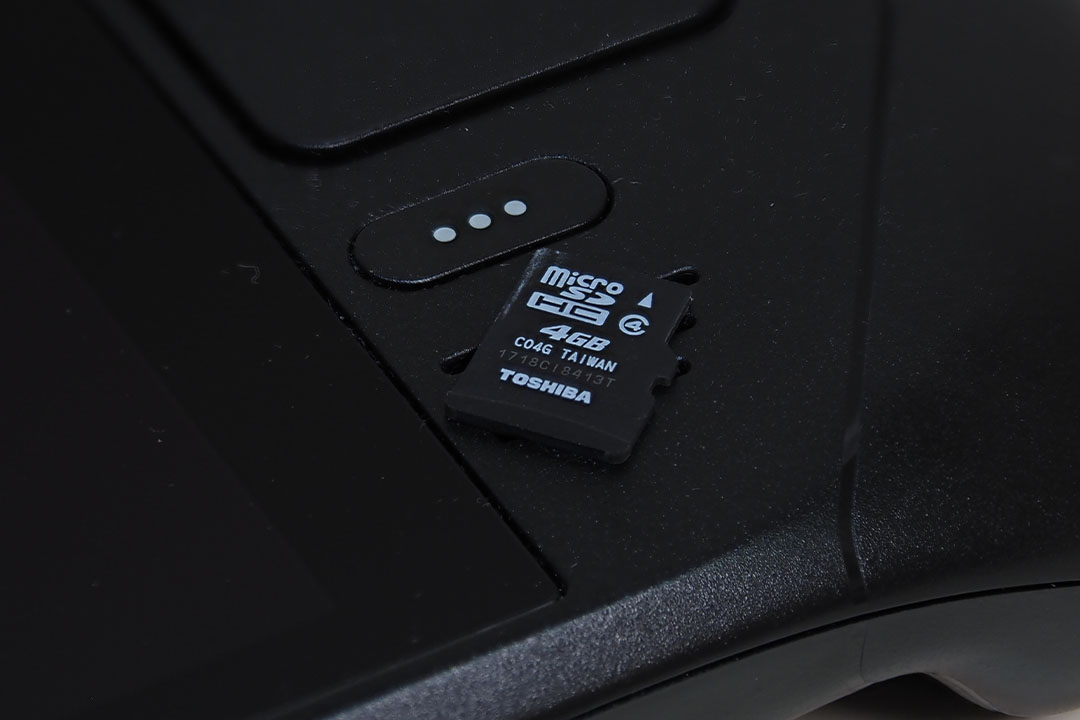
Can I Test a MicroSD Card with Class 10 or lower?
Yes, you can, but same as above: you’re risking extremely slow loading times. Ideally scroll back up and pick one of our recommendations on the best SD card for the Steam Deck, everything else is just roulette.
External Steam Deck Storage vs Internal: Is the Difference Huge?
Obviously, the internal SSD drive outperformed even the best SD card for Steam Deck in both claimed and synthetic benchmarks, but the difference in gaming was between 20 to 30% slower. It’s not a deal breaker, really, and if you’re not a perfectionist, a good quality card will be more than enough to enjoy all of your games.
Can I Expand the Internal Storage of my Steam Deck?
Yes, some internal parts can be exchanged, but it’s not advised. There is a risk of potentially damaging your hardware and voiding the warranty. So, you may want to weigh those risks before making any attempt at dismantling the Steam Desk for any hardware upgrade.
One common question that I saw is if you can upgrade the Steam Deck Micro SD card slot to a newer standard, and for now that’s not possible without entering the heavy DIY territory.
If you want to know more, Valve released a video demonstrating the disassembly of the Steam Deck. You can find it here.
Should I Store My Esports Games on the Steam Deck SD Card?
I’ve played CS:GO and Apex Legends for close to 5 hours each, both running off a SanDisk Extreme MicroSD, and I can’t say that I noticed anything else except the longer loading times.
Still, I wouldn’t recommend keeping your main esports titles on a MicroSD card. Ideally, get the 256 GB Steam Deck and keep them on internal storage, you’ll get much better performance.
Concluding My Steam Deck MicroSD Card Test
I think that this was one of the longest articles I have written in my whole writing career, and the most MicroSD cards I have ever owned. I hope it helped you make a better buying decision, and if you liked my work, be sure to share this article with your friends, on Reddit, in forums and on whichever other media you think might like it. If you would like to ask me any questions, feel free to reach out in this thread: Best SD Card for Steam Deck Reddit.






